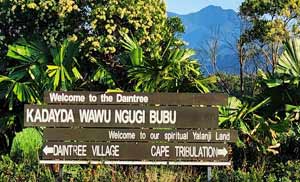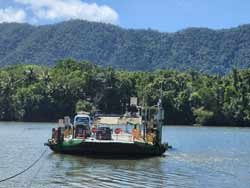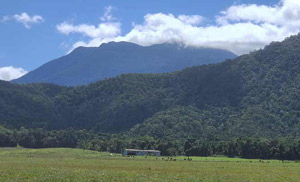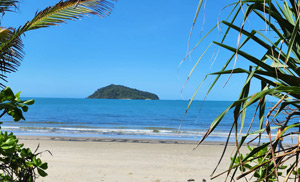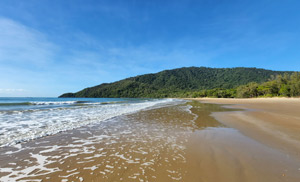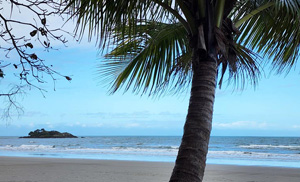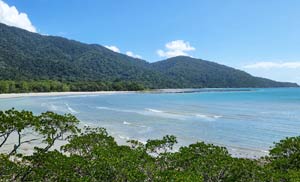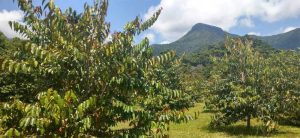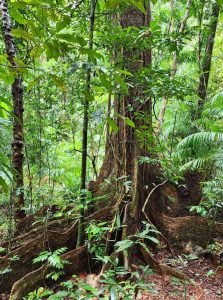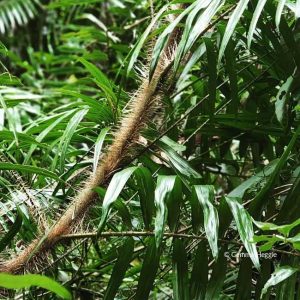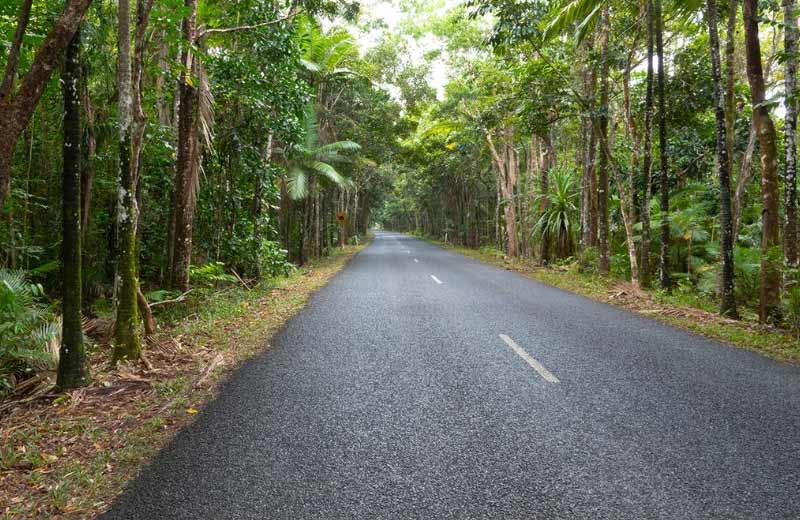
Here you are, on your journey of a life time – travelling through the dense tropical rainforest of the Daintree Coast. You’ve crossed the River on the quaint old Daintree ferry, and entered a strange and ancient world. It’s an exciting journey with steep drop-offs and running cascades as you climb and drop down the winding road over Alexandra Range towards Cow Bay. Each turn reveals more and more intense green diversity reaching out, above and almost surrounding your vehicle. Don’t stop now!
Fifty shapes and fifty shades of green! Maybe the odd splash of red – an Illawara flame tree, or the large blooms of the Golden Bouquet. But mainly green. Ancient tree and king ferns, rare cycads, native bananas, woody vines and bright green fan palm fronds. Just spectacular.
Suddenly you catch a glimpse of it from the corner of your eye – and your passengers first become aware, then excited by this black shape moving slowly in the distance, seemingly growing larger as you approach. Its your lucky day. Not everyone gets to see it – Australia and New Guinea’s own rainforest Big Bird. The Southern Cassowary (casu=horned, weri=head), the Casuarius Casuarius or just cassowary, for short.
This living dinosaur is almost as heavy as Australia’s biggest living megafauna, the red kangaroo!
But… it’s not going to hop, or even fly anywhere. It’s a flightless bird and one of a group of mainly flightless birds called ratites. Ratites of the world also include three cassowary species in New Guinea and islands, one ostrich (Africa), one emu (Australia), five kiwis (New Zealand) and two emas or rheas from South America. All old Gondwana countries. The DNA evidence also now informs us that a family of flightful birds (birds with flight) called Tinamou from South America are also related. Oddly, kiwis and tinamou have four toes; the ostrich three; and the rest, including cassowary, three toes!
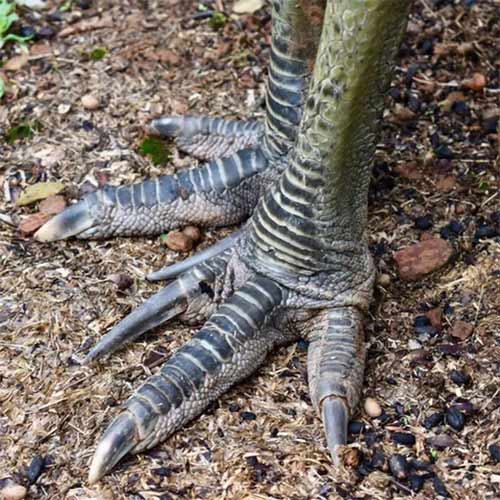
All adult cassowaries have a large mass of black feathers, making them almost invisible once they get a metre or two into the vegetation. The rest of their design is also adapted to heavy rainforest vegetation, with a solid body and short but massively strong legs. They’re not designed for open savannah racing, but their speed through the jungle is scarily fast! And they can easily jump higher than most mere mortals (humans). Mobility and attack/defence are helped by three incredibly thick strong forward pointing toes with vicious keratin toenails, the middle one more like a curved steel spike.
If you get really lucky and come face to face with one of these elusive big birds, you’ll notice their beady piercing eyes, straddling a glum wide beak. Older adults will have a huge helmet or casque at the top of its head, growing larger as they age; and bright blue and red colouring around the wattle and neck. The length of their drooping red double wattle is also another clue to their age – it grows longer over time.
Their fearsome beak has no teeth, and they swallow rather than bite food. One Daintree Coast resident has reported an adult trying to come to grips with a full green papaya (pawpaw). It manoeuvred it around and around for minutes before finally – bang– squashing it with their big foot, then down the gullet! Problem solved. Different birds, different strokes!
Cassowaries are mainly fruit eaters, with some flowers and fungi often thrown in for good measure, depending on the seasonal food supply. But, frankly, when they have the chance, they get very excited with a meal of dead meat (or carrion); or small live birds, insects and reptiles. A few years ago, I saw an emerald dove get too close to an adult cassowary. Big mistake! A few powerful pecks and then the big bird had supper ready for its enthusiastic chicks. I guess that makes it an opportunistic omnivore.

When you are out and about exploring the Daintree boardwalks or just casually strolling around your rainforest accommodation, it’s more than just the big black shape to look for. Keep an eye out for the also big – sometimes colourful – piles of precious poo they leave behind in their travels. Because they swallow their fruit whole, it’s up to their highly acidic digestive juices and strong muscular organs (called gizzards) to grind up the food, separating the flesh from the seeds. The final product is a ready-to-grow mixture of seeds and manure which is soon pooped out as a substantial and often colourful blob. Their seed-nurturing skill makes cassowaries critical (Keystone) agents in spreading out the tropical rainforest characteristically large seeds. If you look out for their blob and examine its contents you’ll know what’s in season in the rainforest. You may even come across some clusters of seedlings alongside the path which on close inspection will reveal an “older blob” where the seedlings have already started to grow.
There’s no point in searching for their rough shallow nest. It’ll be well hidden away from the roads and walking tracks. Of course, while it’s up to Mum to lay the green-coloured eggs, usually 3 to 6 in a nest, it’s the very modern Dad that does the heavy lifting. This means sitting on the eggs and later raising the young. The eggs hatch after about 50+ days, when the hatchlings are called “stripeys”. After a few months, the young teenagers change to a dull brown. When the young become a bit older, Mum will occasionally join the family, but any fright or crisis has the kids quickly scampering back to Dad.
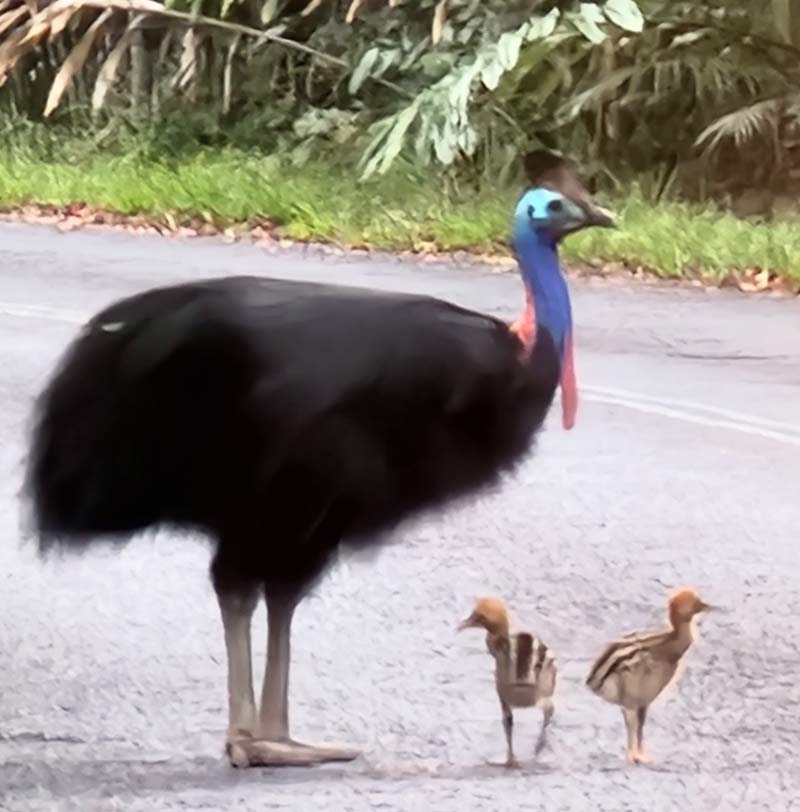
A life-changing event confronts the kids usually between 9 and 18 months old. They will suddenly be kicked (literally) out of Dad’s protection.
The need to breed is strong. The species must go on. An adult female will have had a good look around the available talent, chose one or more for mating, and then she might have to show the kids the way out of the door to free up the male for the next brood. (It helps that she’s 40% bigger than the Dad. Size is important in the cassowary world). Mum and Dad may actually join forces to kick the young out of home. Separation can at times be brutal. One of our local Lodge owners reported an adult often hiding behind a tree, jumping out, chasing, pecking and even kicking at the young until, finally, success! It’s tough love, and it’s definitely a dangerous time for the newly and very reluctantly independent youngsters.
The attrition rate is high in the cassowary world. In the wild, it’s rare for a stripey even to reach maturity let alone have its own young. Tough love in a tough world! And cars with human drivers are a great danger to them along the Daintree Coast. In New Guinea, cars are a lesser issue. The locals prize them for their meat and feathers, and often raise them from the young (or eggs) as a highly valued resource.
Driving carefully is a must, to maximise your chances to see one of those marvels of ancient world and to avoid losing any more on road accidents. And then when you get lucky and find one, get excited but not too much! Usually, adults are quite happy doing their own thing, unless threatened or provoked. Always avoid situations like jumping out of a car to get a closer look, and never get between an adult cassowary and their chick(s). Having a dog present, or even just panicking and running away from it can also cause a defensive reaction. So stay in your car. If you’re on a National Parks boardwalk, don’t get between Dad and chicks, move slowly backwards and be respectful! Teenage cassowaries – especially those recently kicked out of Dad’s protection – can be nervous and overreact easily.
As an ancient megafauna survivor, cassowaries are well equipped to defend themselves vigorously! Firstly, they’re very quick. Their big pecking beaks can hurt, their feet are fearsome and those dinosaur-like toes are vary sharp. They can either jump vertically or hurl themselves sideways to strike at a passing car, an attacking dog, or – as we mentioned earlier – even its own young.
And, not only can cassowaries run fast through the thick vegetation, they can also swim quite well, and can cross deep streams, if they have to. They evolved as rainforest specialists and in northern tropical rainforests, where the heavy rainfall feeds the beautiful postcard-like creeks year round. Of course, they also need to drink and love to cool off in water.
But a cassowary in a creek may also be fishing – without rod and reel, but casting its own net – of sorts. The Big Birds have been seen to settle down in a creek with their feathers spread out. The resultant shadow entices innocent little fish to take refuge under their plumage. The cassowary then clenches its feathers, gets out of the water, shakes itself to release the fish, and eats the catch. Remarkable, maybe rare, but true!
If you stay around the Daintree Coast long enough, you’ll probably come to realise that virtually all cassowary encounters are happy and harmless for humans, and often display the cassowary’s remarkable curiosity. Many local residents, working intently at a work bench, or in the garden, have suddenly sensed a cassowary companion peering over their shoulder. A bit spooky, but just keep your head down and work away until they decide to leave!

There’s still a lot we don’t know about the cassowary. Such as, why do they have that huge casque or helmet on its head? The early naturalists and collectors thought that the casque was a hard bony helmet for head-butting, or perhaps crashing through jungle undergrowth or even knocking fruit from trees. We now know those hypotheses were incorrect as the casque is actually quite light, soft and flexible. Inside the casque are thin cellular bony structures and empty space, not liquid. The outside cover is a keratin sheaf. Keratin, by the way, is what fingernails and claws are made of.
Nowadays scientists have been discussing three possible hypothesis: the casque as a sociosexual attraction, indicating fitness, maturity and vigour; the casque as a low frequency voice box providing a drumlike sonic boom, allowing sound to travel longer distances through the dense forest; and the latest one the casque helping with temperature control as it loses little heat in cool weather but a lot more during hot periods. The jury is definitely still out as to which one or more of these might be primary or secondary purposes in the cassowary casque’s evolution.
Another thing we still don’t know exactly is how many cassowaries we have in Australia. The most comprehensive research (Reef and Rainforest Research Centre in 2014) indicated about 4,400 cassowaries in the Wet Tropics, spread over 23 sub-regions, with a stable population over the last 20-30 years. We know that there are more in the northern part of Cape York, but their numbers have never been counted. Most of the Wet Tropics cassowaries live inside inaccessible rainforest around Tully and the Russell River. South of Cairns, Mission Beach is a great place to spot them.
Along the Daintree Coast between the Daintree and Bloomfield rivers, the official numbers are only around 110. Just over one hundred! So, how come visitors see them so often along Cape Tribulation Road and the (free) National Parks boardwalks? It comes down to the unique geography. The Road runs in a narrow strip between the Coral Sea and the mountains, so the viewing possibilities are unusually high!! So, if you come across a Dad with two chicks, you’ve seen about 3% of the local population. Unforgettable.
So, there’s a very brief introduction to our very special living Dinosaur, the cassowary. Getting to see one at close quarters in the wild is a unique experience, so look out for them on your visit to the Daintree Coast.

Mike D’Arcy
D’Arcy of Daintree
Mike spent many years as an interpretive Wet Tropics Tour Guide running his own business D’Arcy of Daintree 4WD tours. Now retired. Mike has a wealth of knowledge on the Daintree Coast region and continues to share this via his audio tours and blog posts on the Daintree Coast website.
The Daintree Coast website is your guide to this amazing region. Browse our website for local insight, history and information guides to local destinations. Explore our directory for activities and things to do, see and experience. Find Daintree Rainforest accommodation, cafes and restaurants and must-see places.
Daintree Coast – Be Amazed.
